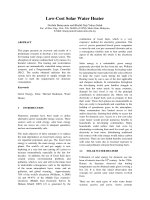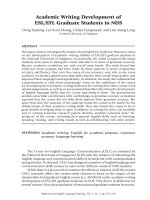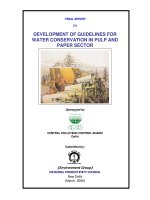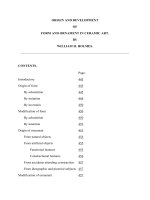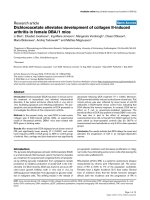Development of low cost solar rack dryer and comparative biochemical quality evaluation of anchovies (Stolephorus commersonii) dried in sun and solar rack dryer
Bạn đang xem bản rút gọn của tài liệu. Xem và tải ngay bản đầy đủ của tài liệu tại đây (250.78 KB, 8 trang )
Int.J.Curr.Microbiol.App.Sci (2020) 9(3): 579-586
International Journal of Current Microbiology and Applied Sciences
ISSN: 2319-7706 Volume 9 Number 3 (2020)
Journal homepage:
Original Research Article
/>
Development of Low Cost Solar Rack Dryer and Comparative Biochemical
Quality Evaluation of Anchovies (Stolephorus commersonii) Dried in Sun
and Solar Rack Dryer
S. Tanuja*, C. S. Mhatre, G. Mohanty, E. Rout, P. Rout and S. K. Srivastava
ICAR-Central Institute for Women in Agriculture, Plot No. 50-51, Mouza - Jokalandi, P.O. Baramunda, Bhubaneswar - 751003, Odisha, India
*Corresponding author
ABSTRACT
Keywords
Low cost solar rack
dryer, Anchovies,
Biochemical quality
Article Info
Accepted:
05 February 2020
Available Online:
10 March 2020
A low cost solar rack dryer was fabricated with an aim to popularise
hygienic drying of fish among fisherwomen and it was evaluated for drying
of Anchovy (Stolephorus commersonii) at Central Institute for Women in
Agriculture, Bhubaneswar, Odisha. It was observed that on an average the
solar dryer attained 17.5 % higher temperature than the ambient
temperature. Within a total drying time of 13 h, the moisture content of the
fish reduced from about 81.97% to 28.87% and 34.43% by the solar rack
dryer and open sun drying respectively. There was significant differences in
the moisture content, crude protein and ash content of fish dried using the
two methods with the solar rack dried fishes significantly faring better. The
values of biochemical quality indicators like Total Volatile Base Nitrogen
and Peroxide value were significantly low in solar rack dried fishes
indicating a longer shelf life of these fishes. Hence it can be concluded that
wide scale dissemination of the low cost solar rack dryer among the coastal
fisherwomen population will help them to earn better returns in their
occupation through sale of the hygienic dry fish.
throughout the coastal belt of India and is the
cheapest means of fish value addition. The
economic returns from fish drying still
remains low because of the unhygienic drying
practices, lack of adoption of scientific
protocol for curing, improved drying practices
Introduction
Dry fish is referred to as poor man’s protein.
Dry fish segment constitutes 20% of the total
fish production in India. Marine fish drying is
the most common form of processing
579
Int.J.Curr.Microbiol.App.Sci (2020) 9(3): 579-586
and packaging. Improved technologies for
drying include the use of mechanical dryers or
solar dryers. The initial investment in
mechanical drying systems is high but dried
fish is stable for extended periods of storage
and is safe for consumption throughout
storage (Reza et al., 2009; Dagne et al.,
2016). The non adoption of these improved
technologies by fisherwomen in developing
countries like India is because of the high
capital investment involved. As a result sun
drying is still the simplest and economical
method of fish preservation practiced all over
the world. But sun drying has many
limitations, such as extended periods of
drying which affects the keeping quality,
inability to dry during rainy season or cloudy
weather conditions, non suitability to high
humid regions etc. Because of these reasons
sun drying of fish often results in low quality,
insect infested and contaminated product.
Hence development and popularisation of
dryers which are cheap yet will serve the
purpose of hygienic and faster drying of fish
is the need of the hour.
humid climate condition of Odisha state of
India (Table 1). This natural convection type
solar dryer was designed to bring down the
moisture content of fish from about 80 % to
25 %.
Design procedure
Design of the solar rack dryer was done
according to Jhajharia and Seveda (2012)
with some modifications. The size of the
dryer was determined as a function of the
drying area needed per kilogram of fresh fish.
The drying temperature was established as a
function of the maximum limit of temperature
which the fresh fish may support.
The mass of water to be removed during
drying, Mw, kg,
Mw =
XW
The mass of water removed per hour mw,
kg/h,
Methods of drying vary with the species used.
The ultimate objective is the reduction in
moisture within the range of 10-35%. The
effect of different drying methods on different
fish species have been studied (Immaculate et
al., 2012; Hasan et al., 2016; Rasul et al.,
2018). The present paper deals with the
development of a cost effective solar rack
dryer to be popularised among fisherwomen
for hygienic drying of fish and to compare the
drying characteristics, nutritional and
biochemical characteristics of Anchovy
(Stolephorus commersonii) dried in the solar
rack dryer and in open sun.
mw =
The total energy required Q kcal,
Q = W* Cp * (Td-Ta)+ (Mw*λ )
The energy required per hour Qt, kcal/h,
Qt =
Collected area required, Ac, m2,
Ac=
Materials and Methods
Construction of the solar dryer
Dryer specifications
The solar dryer (Fig. 1) was designed as per
the above procedure. The required area of
A suitable size natural-convention type solar
dryer for drying fish was designed for the
580
Int.J.Curr.Microbiol.App.Sci (2020) 9(3): 579-586
collector be 3.00 m2, hence the length and
width of dryer was taken 2.45 m and 1.22 m
respectively. The height of the dryer was kept
1.52 for ease of loading and unloading by
women. Slope was also provided to the dryer
roof to avoid pooling of water or debris on top
of it.
Performance evaluation
Anchovy fish (Stolephorus commersonii),
locally known as kokali, was considered for
study in the open sun drying and the natural
convention solar rack dryer. The fresh fish
obtained from local markets of Bhubaneswar
were bought in iced condition to the
laboratory, gutted and washed with clean
water. The initial moisture content of the
sample was determined by drying at 1050C
for 6 hours and was observed to be 81.97 +
0.31 %. The fish was salted (1:8:: Salt: fish)
and kept for 24 hrs in plastic trays covered
with polythene. The polythene was given
holes. After 24 hrs the fish was rinsed in clean
water to remove the excess salt and the water
was drained off. The fishes were divided into
2 batches. Each batch was further divided in 3
replications of 200 g each. One batch was
dried in open and the other in the developed
solar rack dryer.
The standard components solar rack dryer are
frame structure, covering material and drying
trays. These materials used for their
construction are affordable and easily
available in the local market.
According to the material for construction
(Either mild steel or stainless steel), the cost
of construction ranges from Rs 8000 to Rs
12000/dryer.
Frame structure: The frame structure consists
of base frame and doors. The mild steel angle
of 25 X 25 X 3 mm was used in the
fabrication of base frame of the solar dryer.
Mild steel flat of 20 X 3 mm was used in the
fabrication of supporting frame of the solar
dryer and to hold trays. Doors were provided
for ease of loading and unloading.
A wire mesh tray was used to dry the fish in
open sun as well as solar rack dryer. The fish
were arranged in a single layer over the mesh
on nylon net. The dryer was properly oriented
for maximum sunlight reception. The
experiment was conducted in the month of
June, 2019 under the climatic condition of
Bhubaneswar, Odisha, India.
Drying trays: The drying trays were contained
inside the drying chamber and were
constructed from wire mesh and wood, it
allowed drying air to pass through the fish.
Total 12 no. s of trays of dimensions
(LXBXH:: 1.2 X 0.52 X 0.75) can fit inside
the dryer.
Proximate and biochemical analysis
Samples were drawn from each lot in
predetermined intervals to estimate the
moisture content and thence the drying rate.
Once the weight got stabilised, the samples
were packed in HDPE Polythene pouches and
sealed till further analysis. The proximate
composition analysis was done according to
AOAC (2000) All the chemicals used in the
analysis were of analytical grade and supplied
by Himedia, India. Moisture was estimated by
drying in a hot air oven, fat by the ether
extraction and crude protein by the
Covering material: The transparent 200
micron UV stabilized plastic sheet was fixed
on the four side of the frame for the
interception of solar energy. But the bottom
and back sides were fixed by black colored
plastic. It was fasten to the frame using
fastening strips.
Ventilation: 4 chimneys were provided for
ventilation..
581
Int.J.Curr.Microbiol.App.Sci (2020) 9(3): 579-586
Microkjeldahl method and ash was
determined by using Muffle furnace. The
biochemical parameters of The Total volatile
base nitrogen (TVB-N) values were estimated
by the Conway micro diffusion method
(Conway, 1950). Free fatty acid was
estimated from the chroloform extracts of the
sample according to AOAC (2000). Peroxide
value (PV) of dried anchovy was estimated by
a titrimetric method (Yildiz et al., 2013)
decreasing (Fig 2). This is in concurrence
with the findings of Pathare and Jain (2007).
The fish was dried to a constant moisture
content of 28.89+0.31% in 13 hours in solar
dryer, where in the same time the moisture
content was reduced to only 34.43+0.32% in
fish dried in open condition. There was no
further weight reduction observed in the fish
in the open condition. Thus, the dryer gives
desirable moisture content in lower time as
compared to the open condition, saving
drying time.
Statistical analysis
Data sets were analysed parameter wise using
Analysis of Variance (ANOVA). The data
were statistically analysed by statistical
package SAS 9.3. The differences between
the experimental groups were considered
significant at a level of P<0.05.
Proximate composition
The moisture content was significantly lesser
(p<0.05) in solar dried fish than the open
dried fish (Table 3). This could be because of
the comparatively elevated temperatures and
lower relative humidity inside the dryer. This
is advantageous as higher moisture content is
one of the accelerants for microbial and
fungal growth in dried fish. The crude protein
and ash content was significantly (p<0.05)
higher in solar dried fish. This is because of
the significant reduction in moisture content
of the fish which results in aggregation of
other proximate parameters. Several authors
have reported the inverse relationship of
moisture and other proximate parameters in
dried fish (Shrivastava et al., 1974; Relekar et
al., 2014).
Results and Discussion
Drying characteristics
As expected in the month of June, when
monsoon initiates in Odisha, the weather was
cloudy and humidity was high during the time
of experiment. Hence the process of drying
was spread over 4 consecutive days and
different time of day owing to intermittent
bouts of clouds and rain. The temperature for
open condition ranged from 44 to 290C, while
for solar dryer it ranged from 47 to 280C
throughout the test period. The ambient
relative humidity ranged from 93 to 49 % and
for solar dryer is was between 84 to 44 %.
The solar radiation for the duration was as
low as 126 W/ m2 and as high as 773 W/m2.
Hence the moisture loss was recorded at one
hour interval from 9-17 h as and when the
ample sunshine or clear sky was available, till
the samples no longer showed reduction in
weight. The details of the weather condition
are given in Table 2.
Usually open dried fish has a significantly
higher ash content because of deposition of
dust and dirt particles on the fish (Immaculate
et al., 2012; Rasul et al., 2018). In the present
study, the inverse condition occurred
probably because of settling down of dust
particles by the intermittent rains in the month
of June in Odisha. The lowest lipid content
was observed in the dried fish produced by
the open drying method, which might be due
to comparatively higher oxidation of lipids
caused by the uninhibited exposure to the
sun.,
It was observed that with an increase in
drying time, the rate of moisture removal was
582
Int.J.Curr.Microbiol.App.Sci (2020) 9(3): 579-586
deterioration of quality by traditional drying.
Abraha et al., (2017) has reported a much
lesser TVBN content of 20.12 mg% in dried
anchovies. This may be because of the fact
that TVBN in dry fish will also depend upon
the initial quality of fresh fish.
Biochemical quality
The total volatile bases in fish tissues include
ammonia, monomethyl amine, dimethyl
amine, and trimethyl amine etc. which gets
accumulated due to bacterial decomposition
of fish. The increase in these volatile bases
leads to deterioration of odour and flavour in
fish. The average TVB-N values of the dried
anchovy was 50.92 mg/100 g and 76.29
mg/100 g (Table 3) for solar dried and open
dried fish respectively, which is much lower
than the recommended value (100–200
mg/100 g of muscle) for different dried and
salted fish products (Connell, 1995). The
fishes dried in open are prone to all sorts of
contamination
like
environmental,
contamination by pest or animals. The
significantly higher (p<0.05) TVBN content
in open dried fishes shows the faster
Peroxide value is commonly used to assess
rancidity development by oxidation of fats.
As per Sankar et al., (2013), the fat content of
S.commersonii ranged between 1.25 to 2.41%
which puts it under the category of low to
medium fatty fish. Fat oxidation is one of the
factors which affects the quality and shelf life
of dry cured fish especially those of high and
medium fatty fishes. It has been reported that
the peroxide value of herring (Clupea
pallasii) lipids (5.52–11.86 meq/kg), a fatty
fish increased significantly during the drying
period (Shah et al., 2009).
Table.1 Assumptions and conditions for designing of solar rack dryer
Items
Location
Product dried
Drying Period
Initial moisture content (wb, %)
Final Moisture content (wb, %)
Loading Capacity, kg
Assumed drying time, hrs
Global solar radiation, kWh/m2
Sunshine hours per day , hrs
Conditions/ Assumptions
Bhubaneswar
(200 16’N 850 50’ E)
Anchovy Fish
June 2019
80
25
5
24
3.72
4.7
Table.2 Weather parameters during the experiment of drying of Anchovy (S. commersonii)
Particulars
Day 1
Day 2
Day 3
Day 4
Temperature, °C
dryer
open
min max
min
max
28
32
29
32
36
47
32.5
40
35
46
35
44
37
45
36
42
RH, %
dryer
min
max
61
80
49
77
48
84
44
76
583
open
min
max
73
93
57
77
50
93
49
87
Solar Insolation, W/m2
min
max
126
191
411
419
284
434
773
606
Int.J.Curr.Microbiol.App.Sci (2020) 9(3): 579-586
Table.3 Proximate and biochemical characteristics of dried Anchovy (S. commersonii )
Drying methods
Open sun dried
Solar rack dried
P value
Moisture
Crude
Crude
Ash (%)
(%)
protein (%) fat (%)
34.43+0.32
34.5+0.38 3.22±0.48 6.8±0.05
28.89+0.31* 41.33+0.41* 4.31±0.14 8.39±0.25*
<0.0001
0.0021
0.0621
0.0027
FFA (%
Oleic acid)
1.43+0.15
1.59+0.03
0.1362
PV (meq
O2/kg fat)
5.08+0.19
2.33+0.34*
0.0002
TVBN
(mg%)
76.29+1.31
50.92+0.91*
<0.0001
Values represent Mean+ SD of 3 replications; Means bearing asterisks differ significantly
Fig.1 Low cost solar dryer
Fig.2 Drying rate of anchovy (S.commersonii) in solar rack dryer and open sun
A rancid taste often becomes noticeable at
peroxide value of 10–20% (Oparaku et al.,
2010; Enamul et al., 2013). The open dried
fish had a significantly higher highest
peroxide value probably due to the
uninhibited exposure to sun. The peroxide
value in both solar dried and sun dried
anchovies was lower than the recommended
value of 20 meq/kg oil (Table 3).
Free fatty acids are formed through chemical
or
enzyme
linked
hydrolysis
of
584
Int.J.Curr.Microbiol.App.Sci (2020) 9(3): 579-586
triacylglycerides and it indicates the post
mortem degradation of fish. The free fatty
acids are further oxidized to produce
secondary oxidation products, which causes
rancidity of fish and fishery products
(Toyamizu et al., 1981). Generally, lower
acid values indicate better quality of a
product. In this study, the average free fatty
acid values were 1.43 and 1.59 % oleic acid
of lipid in solar dried and open dried
anchovies respectively (Table 3) which is
much less than reported by many authors in
dried fish (Majumdar et al., 2017; Razul et
a.l, 2018). This could be due to the reduced
activity of fish muscle enzyme and
microorganisms because of the removal of
moisture from fish by drying.
AOAC. (2000). Official methods of analysis
(17th Edn.), Association of Official
Analytical Chemists, Washington DC,
USA.
Cho, J.H., Min, B.J., Chen, Y.J., Yoo, Y.S.,
Wang, Q., Kim, J.D. and Kim, I.H.
(2007). Evaluation of FSP (fermented soy
protein) to replace soybean meal in
weaned pigs: growth performance, blood
urea nitrogen and total protein
concentrations in serum and nutrient
digestibility. Asian Australian J. Anim.
Sci., 20:1874-1879
Connell JJ. (1975). Methods for assessing and
selecting for quality. Control of Fish
Quality. Fishing News Books Ltd.,
England, pp.107-132.
Conway, E. J. (1950). Microdiffusion analysis
and volumetric error (3rd Edn.),
Lockwood and Son Ltd., Crosby,
London, pp. 306.
Dagne, T., Guya, M., Abera, S. and Bekele, F.
G. (2016). Effect of drying methods and
pretreatments on nutritional value and
sensory quality of fish (Oreochromis
niloticus, Pylodictis olivaris and Cyprinus
carpio) species commonly used in
gambella region. Turkish Journal of
Agriculture - Food Science and
Technology, 4(1): 22-30.
Francisca, O.N., Obialo, M.B. and Effiong,
E.J. (2010). Proximate and organoleptic
characteristics of sun and solar dried fish.
Animal Research International, 7(2):
1169 – 1175.
Haque, E., Kamruzzaman, M., Islam, M.D.,
Sarwar, T., Rahman, S.S. and Karim.
M.R. (2013). Assessment and comparison
of quality of solar tunnel dried Bombay
duck and Silver pomfret with traditional
sun dried samples. International Journal
of Nutrition and Food Sciences, 2(4):
187-195.
Hasan, M.M., Shikha, F.H., Hossain, M.I.,
Kamal, M., Islam, M.N. and Wahab,
M.A. Quality assessments of traditional,
Hence it can be concluded that by achieving
increased drying temperatures and reduced
relative humidity, the low cost natural
convection
solar
rack
dryers
can
comparatively increase the drying rate to
produce a product with low moisture content
and improved quality compared with the
traditional open sun drying method. This
improvement in terms of quality can help the
fisherwomen get better prices for their fish
and enhance the preferences of consumers.
Acknowledgement
The authors are thankful to ICAR, New Delhi
for financial support, Director ICAR-CIWA
for providing all necessary facilities.
References
Abraha, B., Samuel, M., Mohammud, A.,
Habte-Tsion, H.M., Admassu, H.,. AlHajj, N.Q.M. (2017). A comparative
study on quality of dried anchovy
(stelophorus heterolobus) using open sun
rack and solar tent drying methods.
Turkish Journal of Fisheries and Aquatic
Sciences, 17:1107-1115.
585
Int.J.Curr.Microbiol.App.Sci (2020) 9(3): 579-586
rotary and solar tunnel dried small
indigenous fish products. Bangladesh
Journal of Fisheries Research, 10: 73–84.
Immaculate, J., Sinduja, P. and Jamila, P.
(2012). Biochemical and microbial
qualities of Sardinella fimbriata sun dried
in different methods. International Food
Research Journal, 19: 1699–1703.
Jain, D. and Pathare, P.B. (2007). Study of
drying kinetics of open sun drying of fish,
Journal of Food Engineering, 78: 13151319.
Majumdar, B.C., Afrin, F., Rasul, M.G.,
Khan, M. And Shah, A.K.M.A. (2017).
Comparative study of physico-chemical,
microbiological and sensory aspects of
some sun dried fishes in Bangladesh.
Brazilian Journal of Biological Sciences,
4: 323–331.
Rasul, M.G., Majumdar, B.C., Afrin, F.,
Bapary, M.A.J. and Shah, A.A. (2018).
Biochemical,
Microbiological,
and
Sensory Properties of Dried Silver Carp
(Hypophthalmichthys molitrix) Influenced
by Various Drying Methods. Fishes, 3:
25-30
Relekar, S. S., Joshi, S. A., Gore, S. B. and
Kulkarni A. K. (2014). Effect of
improved drying methods on biochemical
and microbiological quality of dried small
head ribbon fish, Lepturacanthus savala
International. Journal of Fisheries and
Aquatic Studies, 1(5): 60-66.
Reza, S., Bapary, A. B. U. J. and Islam, N.
(2009). Optimization of marine fish
drying using solar tunnel dryer. Journal of
Food Processing and Preservation, 33:
47–59.
Sankar, T. V., Anandan, R., Mathew, S.,
Asha, K.K. Lakshmanan, P.T, Varkey, J.,
Aneesh, P.A. and Mohanty, B. P. (2013).
Chemical composition and nutritional
value
of
Anchovy
(Stolephorus
commersonii) caught from Kerala coast,
India. European Journal of Experimental
Biology, 3(1):85-89.
Seveda, M.S. and Jhajharia, D. (2012).
Design and performance evaluation of
solar dryer for drying of large cardamom
(Amomum subulatum). Journal of
Renewable and Sustainable Energy, 4:
0631292-11.
Shah, A. K. M. A., Tokunaga, C., Kurihara,
H. And Takahashi, K. (2009) Changes in
lipids and their contribution to the taste of
Migaki-nishin (dried herring fillet) during
drying. Food Chemistry, 115 (3): 10111018,
Shrivastava, K. P. and Anandavally, N.
(1974). Studies on the changes in dried
shrimp during long storage at normal
room temperature. Seafood Export
Journal, 6: 9–11.
Toyomizu, M., Hanaoka, K. and Yamaguchi,
K. (1981). Effect of release of free fatty
acids by enzymatic hydrolysis of
phospholipids on lipid oxidation during
storage of fish muscle at −5 ◦C. Bulletin
of the Japanese Society for the Science of
Fish, 47: 605–610.
Yildiz, G., Wehling, R. and Cuppett, S.L.
(2003). Comparison of four analytical
methods for the determination of
peroxide value in oxidized soybean oils.
Journal of the American Oil Chemists
Society, 80: 103-107.
How to cite this article:
Tanuja, S., C. S. Mhatre, G. Mohanty, E. Rout, P. Rout and Srivastava, S. K. 2020.
Development of Low Cost Solar Rack Dryer and Comparative Biochemical Quality Evaluation
of Anchovies (Stolephorus commersonii) Dried in Sun and Solar Rack Dryer.
Int.J.Curr.Microbiol.App.Sci. 9(03): 579-586. doi: />
586
